Our oceans are under massive threat. Marine plastic pollution is a big part of the problem. 12.2 million tons of plastic end up in the ocean every year, causing irreparable damage. But how polluted are the oceans really? And how does plastic actually end up in the ocean?
Current marine plastic statistics and facts:
Every year BeyondSurfing collects and evaluates the latest statistics and scientific findings on the subject of ocean pollution. We have now analyzed over 187+ facts, statistics and studies on ocean pollution and summarized the most important facts for you below.
What many people don’t know:
Our oceans serve as the basis of life on our planet. 97 % of the world’s water is found in the ocean and 70 % of oxygen is produced by marine plants. Find out below how dramatic marine littering is and how badly people are actually affected by pollution in the ocean.
The most important facts in brief:
- Around 8 million pieces of plastic end up in our oceans every day.1
- Over 12 million tons of plastic are dumped into the oceans every year.2
- 79% of plastic waste ends up in landfill sites or in the ocean, only 9% is recycled and 12% is incinerated.3
- Plastics make up 80 % of all marine litter examined.4
- An estimated 5.25 billion pieces of macro- and microplastic are currently floating in the open ocean. They weigh up to 269,000 tons.5
- The “Pacific Garbage Patch” is 1.6 million square kilometers in size, making it three times the size of France or almost five times the size of Germany.6
- More than 1 million seabirds and 100,000 marine mammals are killed by plastic in the ocean every year.7
- Plastic bottles take 450 years to decompose in the ocean.8
- Excessive marine pollution has contributed to the creation of 500 dead zones in the ocean.9
- 1 in 3 fish for human consumption contains plastic.10
Facts about plastic pollution in the ocean
How does plastic get into the ocean?
Two thirds of plastic pollution comes from waste that is washed into rivers and drains and left behind on beaches, in cities or communities. The rest ends up in our oceans through illegal dumping, poorly managed landfills and industries. Every year, 18 billion pounds of plastic flow into the ocean from coastal regions.11
More figures and data on the sources of marine pollution:
- Every year, 18 billion pounds of plastic pollution flow from coastal regions into the ocean.12
- Two thirds of plastic pollution comes from waste that is washed into rivers and drains, left on beaches or dropped in cities.13
- Industrial pollution, waste flushed down toilets and poorly managed landfill sites near the coast all contribute to the problem.14
How much plastic is in the ocean?
➤ 12.2 million tons of plastic parts end up in our oceans every year16
Up to 12.7 million tons of plastic parts end up in our oceans every year. The waste escapes from landfills, floats in our drains, reaches our rivers and thus finds its way into our oceans.
A large proportion of plastic waste is invisible to the naked eye. It collects in ocean eddies, on which marine life feeds. These are not only single-use plastics such as plastic bottles and straws, but also microbeads from cosmetics and fibers from clothing and tea bags.
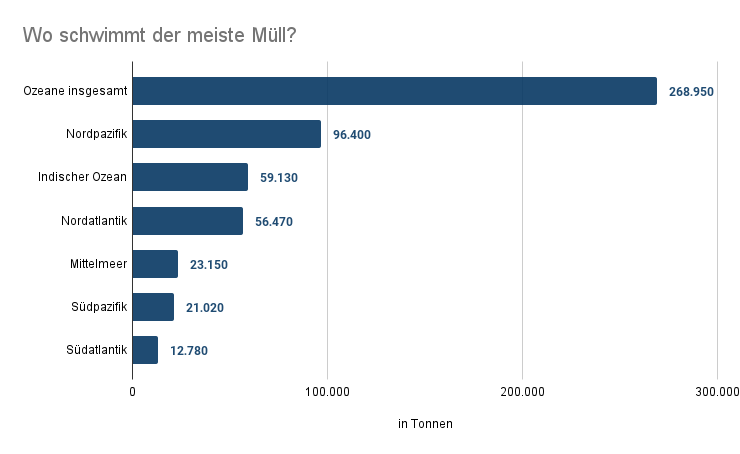
The problem will increase tenfold if we continue to use plastic at this rate. Based on current knowledge, the effects on the ecosystem, marine life and humans may be irreversible.
- Every year, 12.2 million tons of plastic parts are dumped into our oceans.17
- Every day, 8 million pieces of polluted plastic end up in our oceans.18
- 79% of plastic waste ends up in landfill sites or in the ocean, only 9% is recycled and 12% is incinerated.19
- It is estimated that there are 5.25 trillion plastic particles in our oceans, weighing 269,000 tons.20
- This is the equivalent of 1345 blue whales and 500 times the number of stars in our galaxy.21
- 4 billion plastic microfibers per square kilometer litter the oceans.22
- Every year, 380 million tons of plastic are produced, weighing as much as the entire human population, and 50% of it is for single use only.23
- Every minute, a garbage truck full of plastic is dumped into our oceans.24
- Plastic has been found at depths of up to 11 km and contaminates the most remote places on earth.25
- 70 % of the waste sinks into the ocean ecosystem, 15 % floats and 15 % ends up on our beaches.26
- Various studies have found that 80% of marine pollution is caused by plastic.27
- Marine conservationists estimate that there are 46,000 pieces of plastic per mile (squared) in our waters.28
- As plastic decomposes over the course of 100 years, it breaks down into micro parts and can spread all over the planet.
How big is the Great Pacific Garbage Patch?

➤ That is three times the size of France and almost five times the size of Germany.
The Great Pacific Garbage Patch is a floating island of waste that stretches from the west coast of North America to Japan. It is about 1.6 million square kilometers in size and accumulates through an extensive system of currents known as eddies.
The western garbage patch near Japan and the eastern garbage patch on the American west coast near California and Hawaii are connected here and form a large vortex. This consists of 1.8 trillion pieces of plastic, 705,000 tons from the ocean, e.g. fishing nets, and about 56% from land-based activities. For example, when garbage is left on beaches or flushed down the toilet. This also includes poorly organized landfills and industrial waste.
The size of the vast Pacific garbage patch is shocking – these fields are said to be almost five times the size of Germany. It is extremely difficult to measure the exact size, as the fields float on the surface but in some places fall several meters into the depths of the ocean.
The effects of the large Pacific garbage patch on marine fauna are extremely serious. In addition to the large pieces of plastic that are swallowed and in which wild animals become entangled, the plastic waste in this patch blocks the sunlight for plankton and algae. Plankton and algae produce nutrients for other living organisms from carbon and sunlight. If their existence is threatened, the entire food web can change.
More facts and figures about the Great Pacific Garbage Patch:
- The Great Pacific Garbage Patch is 1.6 million square kilometers in size.30
- It is around three times the size of France or almost five times the size of Germany.31
- It contains 1.8 billion plastic parts weighing more than 80,000 tons.32
- The spot floats between Hawaii and California and 46% of the waste consists of fishing nets.33
- This garbage patch consists of two different patches that are connected by the subtropical gyre in the North Pacific.34
- The subtropical gyre in the North Pacific is 20 million square kilometers in size and is formed by four currents (North Pacific, Kuroshio, North Equatorial Current and California Current).35
- 80% of the Pacific garbage island is waste from Asia and North America.36
- 20% of the Great Pacific Garbage Patch comes from oil rigs, Pacific cargo ships and boaters dumping their waste into the water.37
- 705,000 tons of these are fishing nets, which make up the majority of the waste. But all kinds of electrical appliances and toys are also lost from cargo ships.38
About Project Ocean Cleanup
Ocean Cleanup is an organization that develops and scales technologies to rid the oceans of plastic. The organization’s goal is to eliminate 90% of floating plastic pollution in the oceans.
Last year, the non-profit organization achieved a breakthrough. 8 years after its founding and 3 years after the launch of its first cleanup system, the organization has finally been able to effectively collect plastic from the ocean with a scalable ocean cleanup concept.
During 9 test extractions, the organization collected a total of 28,659 kilograms of plastic from the ocean. Although this is only a very small part, it is also the most important, as these kilos prove that a clean-up is possible.39
In July 2022, more than 100,000 kg of plastic was officially removed from the Great Pacific Garbage Patch. System 002, also known as “Jenny”, has been in operation since August 2021 and has collected 101,353 kg of plastic in 45 deployments. The system has thus cleaned an ocean area of over 3000 km2, which is equivalent to the size of Luxembourg.40
What causes plastic pollution in the oceans?
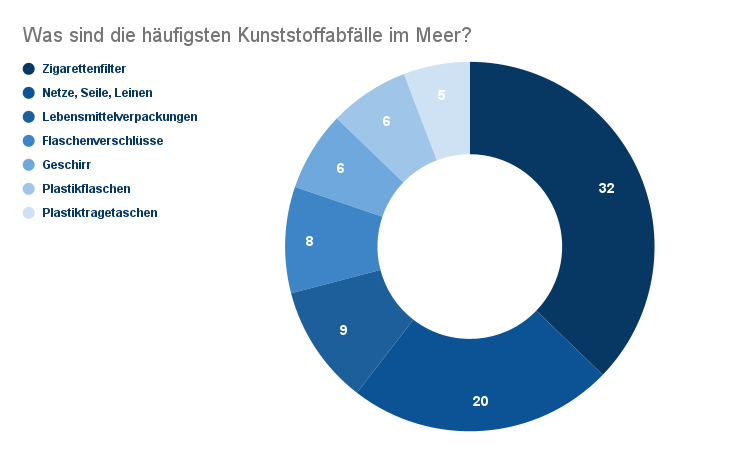
There are numerous reasons for the pollution of the oceans. These include toxic chemicals, nuclear waste and oil spills. However, plastic waste is at the top of this list. Only 9% of single-use plastics, out of a total of 381 million tons of plastic waste per year, are recycled. The rest ends up in landfill sites or in the ocean.41
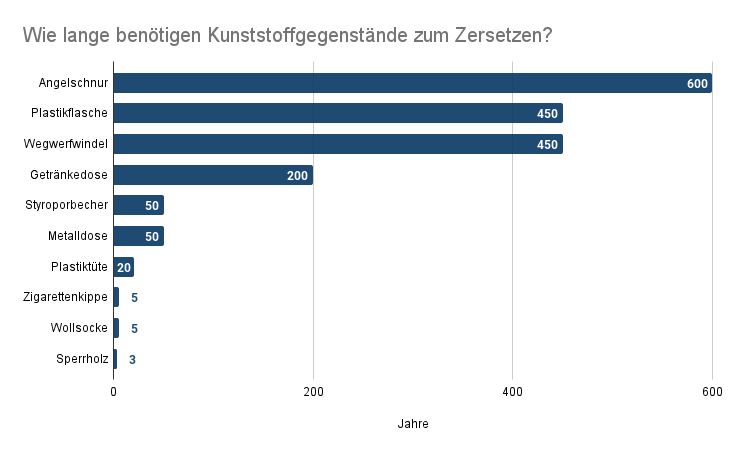
Fishing fleets that leave behind ropes, lines and nets are responsible for 20% of the plastic waste in the ocean. Sea creatures often become entangled in them and are thus held captive.
80% of plastic waste is generated on land, with single-use plastic such as bags and packaging making up the largest proportion. Overflowing sewers, litter left behind by beachgoers, inadequate waste management, construction work and illegal dumping all contribute to the enormous amount of plastic entering our oceans.42
More facts and figures on the causes of plastic pollution in the sea:
- Plastics make up 80 % of all marine litter examined.42
- 20% of all plastic waste in the sea comes from marine sources such as nets, ropes and lines.44
- 32 % of the plastic waste found was cigarette filters, 9 % food packaging, 8 % bottle caps, 6 % tableware, also 6 % plastic bottles and 5 % plastic carrier bags.45
- 60% of the materials used to make clothing are plastics (nylon, acrylic, polyester, etc.). A normal wash produces around 700,000 microplastic fibers.46
- 35% of all primary plastics that end up in our oceans come from textiles – making them the largest source of microplastics.47
- 4,800 million straws are thrown away in Germany every year.48
- In Germany, 9,628 million disposable bottles and 2,800 million coffee cups are disposed of every year.49
- 500 billion plastic bags are used every year – the average life span of these bags is 15 minutes.50
- We consume 500 billion plastic bottles every year – that means there are 66 times as many bottles as people on the planet.51
- 14% of our waste consists of these bottles, less than half is collected for recycling, but only 7% becomes a new bottle.52
- It takes 50 years for polystyrene cups to biodegrade, 200 years for aluminum cans, 450 years for diapers and plastic bottles and 600 years for fishing lines.53
What types of marine pollution are there?
How many fish and marine animals die from plastic pollution in the sea?
Animal species polluted by plastic waste:
- 100 % of the sea turtle
- 56 % of the whales
- 40 % of seabirds
- 36 % of the seals
The exact number of animals that die from plastic pollution in the oceans is unknown. However, it is estimated that over 100,000 marine mammals and over 1 million seabirds are killed by plastic in the ocean every year. Likewise, 100% of baby sea turtles have plastic in their stomachs. The impact of plastic waste on marine life has become a global crisis, with so many animals mistaking plastic pieces and particles for food or becoming entangled in them.60
Animals that ingest plastic are often prevented from eating properly as the plastic fills their stomachs. Organs also rupture or the transportation of food to the intestine is blocked by the plastic. In the Philippines, for example, a curvy mug whale was found. He was vomiting blood and had over 88 pounds (approx. 40 kg) of plastic in his stomach. Because of the plastic waste, his body began to destroy itself from the inside out.61
Plastic pollution is ridding the world of marine species, the facts show. Over 700 species are threatened with extinction, including the Hawaiian monk seal and the loggerhead sea turtle. Not only larger mammals, but also the smallest organisms can be affected by toxic microplastics that make their way through the food chain.62
More facts and figures on the threat of plastic pollution:
- 1 million marine animals die every year from plastic waste alone.63
- 100,000 marine animals die every year because they become entangled in plastic – and these are just the creatures that have been found.64
- 100 % of sea turtles, 59 % of whales, 36 % of seals and 40 % of seabirds surveyed are contaminated with plastic.65
- More than 1 million seabirds and 100,000 marine mammals are killed by plastic in the ocean every year.66
- 700 species of marine animals are threatened with extinction due to plastic.67
- The tuna population has declined by 74% since 1970 and 1 in 4 shark species is threatened with extinction.68
- It is assumed that 90% of all seabirds and fish have plastic particles in their stomachs.69
- Sea turtles caught in fisheries in and around the patch can have up to 74% (dry weight) of their diet made up of plastic.70
- More than two thirds of the world’s fish stocks are suffering from the consumption of plastic.71
- 12,000 – 24,000 tons of plastic are swallowed by fish in the North Pacific every year.72
- Our coral reefs are home to around 25 % of all marine life known to man. If they come into contact with plastic, the probability of illness increases from 4% to 89%.73
Statistics on plastics in the oceans
How many plastic bags are in the ocean?
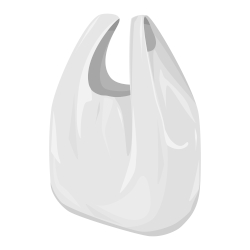
➤ 100,000 marine animals are killed by plastic bags every year.75
➤ 10% of 5 billion plastic bags end up in our oceans.76
Today, plastic bags are one of the most controversial forms of plastic pollution. On average, they are only used for 12 minutes and over 1 million of them are disposed of every minute.
Single-use plastic is responsible for the deaths of over 100,000 marine animals every year. By becoming entangled in wildlife and mistaken for food by larger animals such as whales and turtles, plastic bags contribute to the death of many marine animals. It takes between 20 and 1000 years for them to decompose. Over the years, each bag can kill numerous animals on its way through our oceans.77
More figures and data on plastic bags in the ocean:
- Almost 1 million plastic bags are sold every minute.78
- 100,000 marine animals are killed by plastic bags every year.79
- Every year, up to 5 billion plastic bags are used worldwide – that’s 160,000 per second and around 10% of them end up in our oceans.80
- If you were to line them up, they would circle the globe 4,200 times, or 7 times per hour, and cover an area twice the size of France.81
- Less than 1% of bags are recycled, the rest are thrown away and often end up in our oceans.82
- On average, plastic bags are only used for 12 minutes and then disposed of.83
- Plastic bags take up to 20 years to completely decompose in the ocean.84
- It is estimated that 300 million plastic bags end up in the Atlantic Ocean alone every year.85
- A constant annual decline in plastic bag consumption can be observed. This means that consumption was reduced by 76 % between 2000 and 2019.86
How many plastic straws are there in the ocean?
➤ 4,800 million straws are thrown away in Germany every year.88
➤ 7.5 million plastic straws were found on the US coast within 5 years.89
Statistics on single-use plastic show that plastic straws are among the 10 most common items found at the international coastal cleanup Ocean Conservancy. The heartbreaking video of the sea turtle with the straw in its nose went viral and helped launch the anti-plastic straw movement.90
In various countries, large companies such as McDonalds have banned plastic straws in restaurants. This does help to reduce the billions of plastic straws that are used every year. However, plastic straws only make up around 1% of plastic waste in the ocean.91
More figures and data on plastic straws in the ocean:
How many plastic bottles are in the ocean?
➤ 14% of all marine litter comes from drinks packaging.97
➤ 16,700 plastic bottles are bought every second.98
➤ O nly 7% of the bottles collected are used to make new bottles.99
Perhaps the exact number of plastic bottles in the ocean will never be known. However, of the 500 billion plastic bottles we consume each year, less than half are recycled. This means that the rest ends up in our waters and in landfills.
Many of the plastic bottles used worldwide are used for drinking water. China is responsible for the increase in demand in recent years. In addition, large beverage companies such as Coca Cola produce the most plastic bottles. According to Greenpeace, it is estimated that they produce over 100 billion plastic bottles every year.100
Combined with poor waste management and recycling, the high volume of plastic bottles contributes to marine pollution. These bottles can last for 450 years and are absorbed by marine life. When the plastics decompose, they form thousands of floating microplastics. These in turn are life-threatening for fish and mammals.101
More figures and data on plastic bottles in the ocean:
- 500 billion plastic bottles are used every year – that means there are 66 times as many bottles as people on the planet.102
- In Germany, 17.4 billion single-use plastic bottles are consumed every year.103
- A plastic bottle can last 450 years in the marine environment.104
- In 2016, more than 480 billion plastic bottles were sold worldwide, compared to around 300 billion ten years ago.105
- 14% of all waste comes from drinks packaging.106
- Less than half of the bottles purchased in 2016 were recycled107
- 7% of the bottles collected were used to produce new bottles.108
- 16,700 plastic bottles are bought every second.109
Which countries cause the most marine pollution?
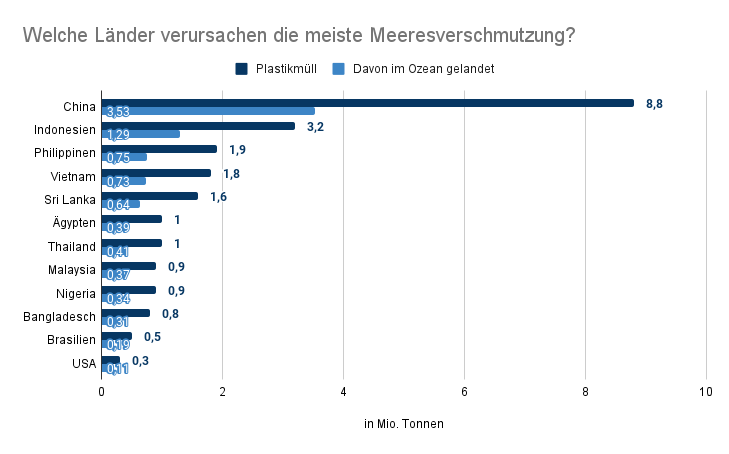
According to Statista, China was responsible for 8.8 million tons of incorrectly disposed waste in 2010. An estimated 3.53 million tons of this ended up in our oceans. However, it should be noted that China has the largest population in the world.
Indonesia has 264 million inhabitants and produced 3.2 million tons of incorrectly disposed waste, of which 1.29 million tons ended up in the oceans.
In comparison, 327 million people live in the United States and 0.11 million tons of waste end up in the sea.110
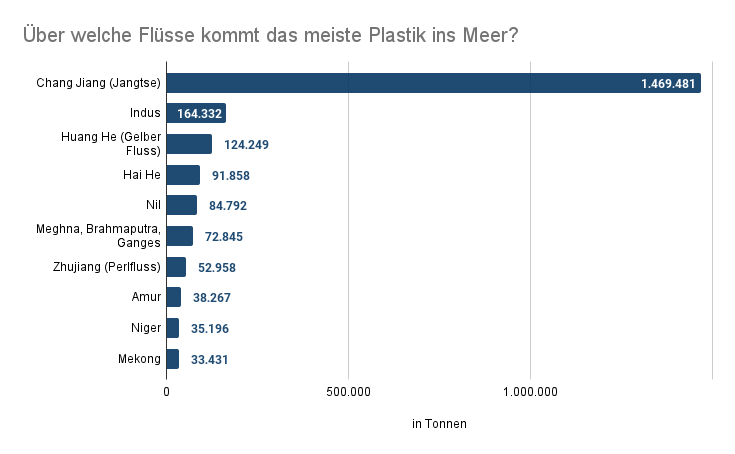
90% of the world’s marine litter comes from just 10 rivers. Of these, 8 rivers are in Asia and 2 in Africa. The Asian river Chang Jiang (Yangtze River) carries 1,469,481 tons of waste into our oceans every year, compared to 41,700 kilograms of plastic washed into the ocean by the Elbe. Other main polluters are Indonesia, the Philippines, Vietnam, Sri Lanka and Egypt.111
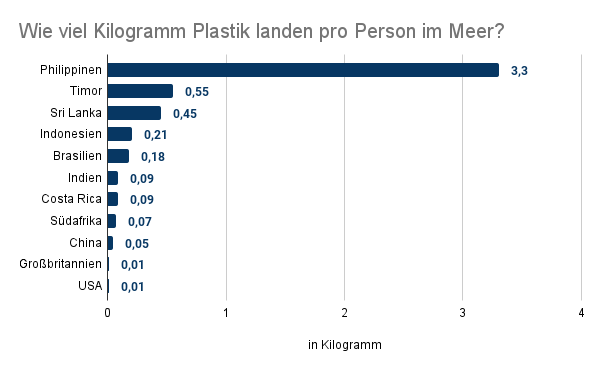
In the Philippines, 3.3 kg of plastic per person ends up in the ocean, the most in the world. Far behind with 0.55 kg of plastic per person is the country of Timor. In comparison, only 0.01 kg of plastic per person ends up in the ocean in the UK and USA.112
- The country with the greatest environmental pollution worldwide is China.113
- The top 10 worst polluters include Indonesia, the Philippines, Vietnam, Sri Lanka and Egypt.114
- The top 5 countries are responsible for 60% of all marine plastic pollution.115
- 50% of the world’s plastic is produced in Asia; 18% of the world’s population lives in China and 29% of this plastic is produced there.116
- 90% of the world’s marine litter comes from just 10 rivers.117
- Eight of these rivers are located in Asia: Yangtze, Yellow, Indus, Hai He, Ganges, Mekong, Amur and Pearl.118
- The Nile and the Niger in Africa are the other two.119
- The Elbe washes 41,700 kilograms of plastic into the sea every year.120
- In the Philippines, 3.3 kg of plastic per person ends up in the ocean.121
Where does the plastic waste in the Mediterranean come from?

Ranking of rivers worldwide
Plastic pollution in the Mediterranean is caused most by the countries of Egypt, Montenegro and Albania. Spain, France, Greece, Croatia and Israel contribute the least to pollution.
More figures and data on marine pollution in the Mediterranean:
- There is an average of 1.25 million plastic fragments per km².122
- 7% of global microplastics are said to float in the Mediterranean.123
- The plastic problem in the Mediterranean is illustrated by the 2:1 ratio between plankton animals and microplastic particles.124
- Every year, 0.57 million tons of plastic are washed into Mediterranean waters. This is equivalent to 33,800 plastic bottles entering the sea ocean minute.125
- The Mediterranean region is the world’s fourth largest producer of plastic goods, and its inhabitants and visitors generate 24 million tons of plastic waste every year.126
- The Nile is said to carry up to 3.3 million tons of plastic into the European Mediterranean every year.127
- In the Mediterranean region, up to 720 kg of municipal waste is generated per capita every year.128
- 6.5 million tons of plastic produced in the Mediterranean region are disposed of improperly.129
Statistics on the impact of marine pollution
What impact does plastic have on the environment?
In 2019, 368 million tons of plastic were produced worldwide, destroying parts of the environment. If we don’t change our plastic consumption, the impact of plastic waste on the environment will be irreparable.130
Map with dead zones in the ocean due to plastic waste:

Pollution with toxic substances turns the marine environment into dead zones. The oxygen content in these areas decreases to such an extent that it leads to the extinction of aquatic plants. It also forces marine life to migrate to other parts of the ocean, disrupting the entire ecosystem.131
Marine plants produce 70 % of our oxygen. 30 % of CO2 emissions are absorbed by the oceans. So, together with the chemicals released during the production of plastic, we have a major impact on the toxicity of our air and our ecosystem. This inevitably leads to health problems for animals and humans.132
More figures and data on the consequences and effects of plastic waste:
- We have produced over 368 million tons of plastic – around 18 million tons of it in Germany.133
- Excessive marine pollution has contributed to the creation of 500 dead zones in the ocean, equivalent to the area of the United Kingdom (245,000 km²) – a number that will double every decade.134
- The lack of oxygen in the dead zones causes marine life to migrate to new areas, upsetting the balance of marine life in other parts.135
- 70% of the earth’s oxygen is produced by marine plants.136
- 30% of our CO2 emissions are absorbed by the oceans.137
How does marine pollution affect humans?

Gonstalla (2017): The ocean book.
➤ Seafood lovers eat 11,000 pieces of toxic plastic every year.139
In order to survive, humans need a harmonious relationship with our planet’s oceans – this is no illusion! 70% of the oxygen we breathe is actually produced by marine plants. What we do on land has an impact on what happens off the coast. For example, 30% of our CO2 emissions are absorbed by the oceans. Our waste disposal also has a major influence on the toxicity of the ecosystem and the animal world.140
The plastics, metals and chemicals found in polluted water have an impact on humans by contaminating our own seafood and water supplies. Damage to the nervous system, low blood pressure problems, reproductive disorders or hormonal problems are just a few examples of the range of serious problems that can be caused.141
More figures and data on the effects on people:
- 1 in 3 fish for human consumption contains plastic.142
- It is estimated that seafood lovers eat 11,000 pieces of toxic plastic every year.143
- Microplastics can be found in tap water, beer and salt.144
- Numerous chemicals used to make plastic are known carcinogens and can disrupt the body’s endocrine system, leading to reproductive, neurological and immune disorders in humans and wildlife.145
- 95% of adults in the USA have BPA levels in their urine.146
- Contamination of coastal waters is responsible for 250 million clinical cases of human disease every year.147
- Only one in 20 adults who bathe in waters that are considered “acceptable” by microbiological standards are at risk of falling ill after a single swim.148
- At the current rate, our waters will be 150% more acidic by the end of the century than they are today.149
- 80 % of the wastewater discharged into the Mediterranean is untreated.150
- Contaminated shellfish is the cause of 50,000 to 100,000 deaths per year due to damaged immune systems and cancer.151
- People who eat mainly seafood, such as the indigenous peoples of the Canadian Arctic and Greenland, are contaminated by POPs (persistent organic pollutants).152
- 100% of the population of East Greenland is contaminated with blood.153
- The direct medical and health costs caused by polluted waters amount to 16 billion dollars per year worldwide.154
- The economic losses caused by the introduction of non-native species into the oceans run into the hundreds of millions of dollars.155
- 70% of the oxygen that we and other land animals need comes directly from the ocean.156
What can we do about littering and plastic pollution?
After all these shocking facts, the question arises as to what each of us can do to reduce plastic pollution. BeyondSurfing has put together 5 tips below that are easy to implement in everyday life.157
Frequently asked questions and answers
It is estimated that there are 5.25 trillion microscopic pieces of plastic in our oceans. There are about 4 million microfibers per square kilometer under the surface of the water.
Marine plastic pollution weighs approximately 269,000 tons. This corresponds to the amount of approx. 1,345 adult blue whales or 500 times the number of stars in our galaxy.
In total, 70 % of the waste ends up in the ocean ecosystem, 15 % floats and 15 % ends up on our beaches.159
Marine animals such as seabirds, whales, fish and turtles mistakenly ingest plastic as food and starve to death because their stomachs are filled with plastic waste. Every year, around 1 million marine creatures die from plastic waste in the sea.160
Likewise, 70 % of the oxygen we need to breathe is produced by marine plants. This means that people who do not eat fish are still affected.166
The size of the large Pacific garbage patch is shocking – the plastic island is three times the size of France and consists of around 1.8 trillion pieces of plastic.169
Even if we managed to get all the floating parts out of the ocean, what would we do with them? That’s why we need to stop consuming more.
References
- 1. assessment document of land-based inputs of microplastics in the marine environment
- 2. plastics in the marine environment
- 3 Ocean Plastic: What You Need to Know
- 4 Ocean Plastic: What You Need to Know
- 5 Plastic Pollution in the World’s Oceans: More than 5 Trillion Plastic Pieces Weighing over 250,000 Tons Afloat at Sea
- 6 Evidence that the Great Pacific Garbage Patch is rapidly accumulating plastic; Almost five times the size of Germany: Garbage vortex in the Pacific more gigantic than expected; The huge floating island of trash in the Pacific Ocean is now twice the size of Texas
- 7. PLASTIC STATISTICS
- 8. plastic lasts forever in the oceans
- 9 Ocean Pollution Facts, Stats, and Solutions
- 10 Occurrence of microplastics in the gastrointestinal tract of pelagic and demersal fish from the English Channel
- 11. HOW DOES PLASTIC END UP IN THE OCEAN?
Pollution – Facts and figures - 12. fast facts about plastic pollution
- 13. HOW DOES PLASTIC END UP IN THE OCEAN?
- 14 Pollution – Facts and figures
- 15. plastic pollution facts
- 16 Plastics in the Marine Environment
- 17 Plastics in the Marine Environment
- 18th Assessment document of land-based inputs of microplastics in the marine environment
- 19 Ocean Plastic: What You Need to Know
- 20 Plastic Pollution in the World’s Oceans: More than 5 Trillion Plastic Pieces Weighing over 250,000 Tons Afloat at Sea
- 21. 10 Shocking Facts About Plastic Pollution
- 22nd Ocean Trash: 5.25 Trillion Pieces and Counting, but Big Questions Remain
- 23rd Plastic Pollution Facts
- 24.every minute, one garbage truck of plastic is dumped into our oceans. This has to stop
- 25th Plastics found in stomachs of deepest sea creatures
- 26th Great Pacific Garbage Patch
- 27 Ocean Plastic: What You Need to Know
- 28. PLASTIC STATISTICS
- 29. Evidence that the Great Pacific Garbage Patch is rapidly accumulating plastic
- 30. Evidence that the Great Pacific Garbage Patch is rapidly accumulating plastic
- 31. almost five times the size of Germany: garbage vortex in the Pacific more gigantic than expected
The huge floating island of trash in the Pacific Ocean is now twice the size of Texas - 32. THE GREAT PACIFIC GARBAGE PATCH
- 33. THE GREAT PACIFIC GARBAGE PATCH
- 34th Great Pacific Garbage Patch
- 35th Great Pacific Garbage Patch
- 36th Great Pacific Garbage Patch
- 37th Ocean Plastic: What You Need to Know
- 38 The Most Dangerous Single Source of Ocean Plastic No One Wants to Talk About
- 39. THE LARGEST CLEANUP IN HISTORY
- 40. FIRST 100,000 KG REMOVED FROM THE GREAT PACIFIC GARBAGE PATCH
- 41st Ocean Plastic: What You Need to Know
- 42nd Ocean Pollution Facts, Stats, and Solutions
- 43rd Ocean Plastic: What You Need to Know
- 44th Ocean Pollution Facts, Stats, and Solutions
- 45th Ocean Pollution Facts, Stats, and Solutions
- 46. release of synthetic microplastic plastic fibres from domestic washing machines: Effects of fabric type and washing conditions
- 47th Plastic Pollution Causes, Facts & Figures
- 48. so much single-use plastic is produced in Germany
- 49th This is how much single-use plastic is produced in Germany
- 50th Plastic Pollution Facts
- 51. 9 Things you can do
- 52. seven charts that explain the plastic pollution problem
- 53. plastic lasts forever in the oceans
- 54th Ocean Pollution: The Dirty Facts
- 55 Plastic Pollution in the World’s Oceans: More than 5 Trillion Plastic Pieces Weighing over 250,000 Tons Afloat at Sea; PLASTIC STATISTICS
- 56th Ocean Pollution Facts, Stats, and Solutions
- 57th Ocean Pollution: The Dirty Facts
- 58. plastic pollution
- 59th Plastic Pollution Facts
- 60th Plastic Pollution Facts
PLASTIC STATISTICS - 61. this young whale died with 88 pounds of plastic in its stomach
- 62 Eight Million Tons of Plastic Dumped in Ocean Every Year
- 63rd Plastic Pollution Facts
- 64. PLASTIC STATISTICS
- 65. plastic pollution
- 66. PLASTIC STATISTICS
- 67 Eight Million Tons of Plastic Dumped in Ocean Every Year
- 68 The huge floating island of trash in the Pacific Ocean is now twice the size of Texas
- 69. 10 Plastic Pollution Facts That Show Why We Need To Do More
- 70. HOW OCEAN PLASTICS TURN INTO A DANGEROUS MEAL
- 71. PLASTIC STATISTICS
- 72. OCEAN PLASTICS POLLUTION
- 73. plastic waste associated with disease on coral reefs
Biodiversity - 74. fast facts about plastic pollution
- 75 Plastic Bags Versus Microbeads: What is the Biggest Threat to Marine Animals?
- 76. how many plastic bags are used each year?
- 77. plastic in our oceans is killing marine mammals
- 78. fast facts about plastic pollution
- 79 Plastic Bags Versus Microbeads: What is the Biggest Threat to Marine Animals?
- 80. how many plastic bags are used each year?
- 81. PLASTIC STATISTICS
- 82. how many plastic bags are used each year?
- 83 How many plastic bags are used each year?
- 84. plastic lasts forever in the oceans
- 85. how many plastic bags are used each year?
- 86. KUNSTSTOFFTRAGETASCHE.INFO
- 87 Do plastic straws really make a difference?
- 88 This is how much single-use plastic is produced in Germany
- 89 No One Knew How Many Plastic Straws Americans Use Every Day. Then a 9-Year-Old Kid Did the Math
- 90 How Plastic Straws Affect the Ocean and Sea Turtles
- 91. 22 Big Companies That Are Getting Rid of Plastic for Good
- 92 This is how much single-use plastic is produced in Germany
- 93. do plastic straws really make a difference?
- 94 No One Knew How Many Plastic Straws Americans Use Every Day. Then a 9-Year-Old Kid Did the Math
- 95 No One Knew How Many Plastic Straws Americans Use Every Day. Then a 9-Year-Old Kid Did the Math
- 96. 9 Things you can do
- 97th Plastic Pollution Facts
- 98th We buy a million plastic bottles a minute
- 99th A million bottles a minute: world’s plastic binge ‘as dangerous as climate change’
- 100 A million bottles a minute: world’s plastic binge ‘as dangerous as climate change’
- 101. Plastic lasts forever in the oceans
- 102. 9 Things you can do
- 103. Reusable is climate protection
- 104. Plastic lasts forever in the oceans
- 105 We buy a million plastic bottles a minute
- 106. Plastic Pollution Facts
- 107 A million bottles a minute: world’s plastic binge ‘as dangerous as climate change’
- 108 A million bottles a minute: world’s plastic binge ‘as dangerous as climate change’
- 109. we buy a million plastic bottles a minute
- 110. these countries pollute the world’s oceans particularly heavily; Fast facts about plastic pollution; The 20 countries with the largest population in 2021
- 111 Our planet is drowning in plastic pollution-it’s time for change!; Elbe washes 42,000 kg of plastic into the sea every year
- 112. ScienceAdvances
- 113. These countries pollute the world’s oceans particularly heavily
- 114. These countries pollute the world’s oceans particularly heavily
- 115. Fast facts about plastic pollution
- 116. Fast facts about plastic pollution
- 117. Our planet is drowning in plastic pollution-it’s time for change!
- 118. Our planet is drowning in plastic pollution-it’s time for change!
- 119. Our planet is drowning in plastic pollution-it’s time for change!
- 120. Elbe washes 42,000 kg of plastic into the sea every year
- 121. ScienceAdvances
- 122. WWF (2019): STOP THE FLOOD OF PLASTIC
- 123. Plastic Atlas (2019): Facts and figures about a world full of plastics
- 124 Werner et al (2016): Harm caused by Marine Litter
- 125. WWF (2019): STOP THE FLOOD OF PLASTIC
- 126. WWF (2019): STOP THE FLOOD OF PLASTIC
- 127. Ranking of the world’s rivers that flush the largest amount of plastic waste into the sea in 2017
- 128. WWF (2018): Ways out of the plastic trap
- 129. WWF (2019): STOP THE FLOOD OF PLASTIC
- 130. Global and European plastics production in the years from 1950 to 2019
- 131. What is a dead zone?
- 132 Save the Plankton, Breathe Freely; Ocean Pollution: The Dirty Facts
- 133 Global and European plastics production in the years from 1950 to 2019; production volume of the plastics industry in Germany in the years 2006 to 2020
- 134. Ocean Pollution Facts, Stats, and Solutions
- 135. What is a dead zone?
- 136. Save the Plankton, Breathe Freely
- 137. Ocean Pollution: The Dirty Facts
- 138. Occurrence of microplastics in the gastrointestinal tract of pelagic and demersal fish from the English Channel
- 139. Seafood lovers eat 11,000 pieces of plastic each year with just one portion of mussels containing up to 90 particles, scientists warn
- 140. Save the Plankton, Breathe Freely
Ocean Pollution: The Dirty Facts - 141. A staggering amount of waste – much of which has only existed for the past 60 years or so – enters the oceans each year.
- 142. Occurrence of microplastics in the gastrointestinal tract of pelagic and demersal fish from the English Channel
- 143. Seafood lovers eat 11,000 pieces of plastic each year with just one portion of mussels containing up to 90 particles, scientists warn
- 144. Anthropogenic contamination of tap water, beer, and sea salt
- 145. Plastic pollution
- 146. Plastic pollution
- 147. Pollution – Facts and figures
- 148. Pollution – Facts and figures
- 149. Ocean Pollution: The Dirty Facts
- 150. Ocean Pollution Facts, Stats, and Solutions
- 151. Pollution – Facts and figures
- 152. Pollution – Facts and figures
- 153. Pollution – Facts and figures
- 154. Pollution – Facts and figures
- 155. Pollution – Facts and figures
- 156. Save the Plankton, Breathe Freely
- 157. 10 TIPS FOR LESS PLASTIC
- 158. OCEAN PLASTICS POLLUTION
- 159. Plastic Pollution in the World’s Oceans: More than 5 Trillion Plastic Pieces Weighing over 250,000 Tons Afloat at Sea; 10 Shocking Facts About Plastic Pollution
- 160. Marine plastics
- 161. Plastic lasts forever in the oceans
- 162. Plastic Pollution in the World’s Oceans: More than 5 Trillion Plastic Pieces Weighing over 250,000 Tons Afloat at Sea; PLASTIC STATISTICS
- 163. Plastics in the Marine Environment; World’s Oceans Clogged by Millions of Tons of Plastic Trash
- 164. The New Plastics Economy: Rethinking the future of plastics
- 165. Plastic pollution
- 166. Save the Plankton, Breathe Freely
- 167. Explaining ocean warming : causes, scale, effects and consequences
- 168. Evidence that the Great Pacific Garbage Patch is rapidly accumulating plastic
- 169. THE GREAT PACIFIC GARBAGE PATCH
- 170. THE LARGEST CLEANUP IN HISTORY
Note: BeyondSurfing is not responsible and is not liable for the content of external websites.

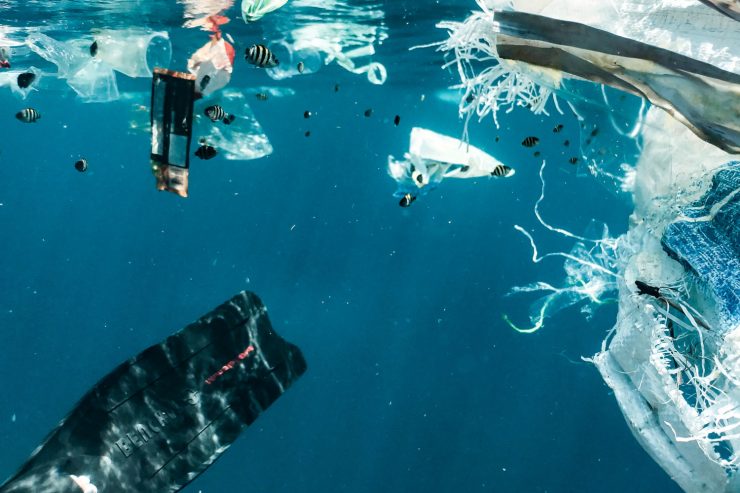






Add comment